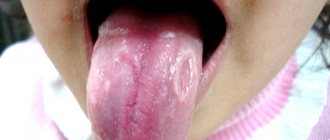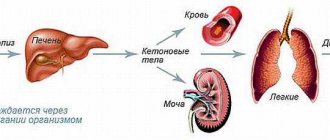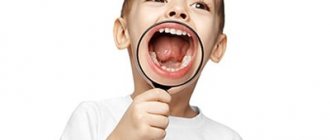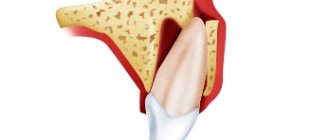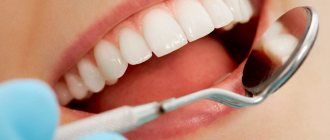Kinds
There are several types of occlusion anomalies; in pediatric orthodontics, there are six.
The following types are distinguished:
- deep – it is characterized by excessive overlap of the upper jaw of the lower jaw;
- cross - with this violation of closure, there is underdevelopment of the jaws on one side, with a characteristic intersection of the lower and upper dental arches;
- mesial - it is typical for the lower jaw to move forward, with the lower incisors overlapping the upper ones;
- open - with this disorder there is no closure of the upper and lower incisors, the patient has a gap between them;
- distal - with this anomaly, the upper incisors move forward, this sign is combined with underdevelopment of the lower jaw and a reduction in the lower part of the face;
- underestimated - characterized by underestimated closure, due to premature abrasion of teeth.
Before starting correction, it is necessary to establish the type of occlusion violation.
Malocclusion in a child...
The purpose of the article is to help parents notice early malocclusion in a child Early treatment will prevent the development of serious pathology. Here I will try to formulate what specifically should alert a mother and make her think about the need to see an orthodontist...
So, by what signs can an attentive mother suspect future problems even at such a tender age?
1. Noticeable tension in the lips and chin when swallowing.
If your child swallows food and saliva noticeably to others, that is, this process occurs with the participation of facial muscles, this may indicate an incorrect position of the tongue, which indirectly indicates an incorrect bite...
2. Mouth breathing.
With prolonged disruption of nasal breathing, the tongue in the oral cavity is not located in the upper floor (as with normal breathing), but in the lower one. This position of the tongue leads to underdevelopment of the upper jaw, it becomes narrow and short, interdental relationships with the lower jaw are disrupted, and malocclusion develops.
3. Asymmetrical face.
Normally, baby teeth should wear down over time; this is the so-called physiological wear of teeth; in some cases, for various reasons, this process may be disrupted. And in combination with a violation of the timing of teething or early loss of teeth, this can lead to an unwanted displacement of the lower jaw, then the child’s face may look asymmetrical.
4. Incorrect overlap of teeth.
5. Early loss of baby teeth.
If baby teeth are removed ahead of schedule, you should also contact an orthodontist. The doctor will definitely offer you preventive prosthetics, its goal is to prevent baby teeth from moving and taking the wrong place in the mouth...
6. Untimely eruption or absence of a permanent tooth germ.
If a child has erupted, for example, all of his fifth teeth except one, then this should alert you. This picture often occurs in the lower jaw, because these are the teeth that appear last, and they often do not have enough space... In such a situation, the tooth remains blocked in the jaw. But there may be another reason - when the germ of a permanent tooth is completely absent.
7. Bad habits.
Thumb sucking, prolonged sucking on a pacifier (after a child is 1.5 years old), biting the lip, pushing the lower jaw forward - all these children's pranks seem to parents to be harmless weaknesses of their beloved babies. How cute do babies look when they suck their thumb...
BUT... Be careful, parents! This can become a habit, and then in adulthood your child will not thank you. Because external force can affect the shape and direction of jaw growth. Thumb sucking prevents the lower jaw from growing and deforms the upper jaw. These are the possible consequences.
There is a helper to help you eradicate this habit. It looks, of course, like an instrument of medieval torture, but in the war against bad habits, all means are good.
To help parents wean their child from the pacifier, there are also special orthodontic devices that train the lips and force them to keep the tongue in the correct position. They are offered to the child instead of his favorite pacifier.
By analogy, other bad habits can cause the same problems. For example, constant biting of lips, sucking of the lower lip.
8. Genetics.
Very often, the size and shape of the jaws are inherited by the child. Parents may be happy about this, or they may be afraid of it... If mom or dad has crowded teeth, narrow jaws, or, for example, a massive lower jaw and chin, then this may also be a reason to contact an orthodontist. With early treatment, it is possible to correct the child’s face, make it more harmonious, and it is possible to “grow” the jaw so that the teeth are evenly spaced. The whole problem is that the child has a small face... and a slight disharmony may be invisible to dental therapists and parents, especially since their child is always the most beautiful for them. But the orthodontist will be able to see the nuances that, as the facial bones grow, can later turn into a problem.
9. Increased abrasion of dental tissue.
In case of teeth grinding, there is no need to urgently run with your child to get tested for “eggworm”; it is better to take him to an orthodontist, the effect will be much greater. At the same time, of course, it would not hurt to show it to a neurologist, but this is after consultation with a pediatrician... The dentist can only direct to identify the cause, and he himself is only struggling with the consequence of the problem. With systematic clenching of the jaws and excessive pressure on the teeth, the enamel begins to wear off, and then the dentin of the tooth. Teeth become short. And everything would be fine... Usually parents console themselves with the fact that these are baby teeth, in a permanent dentition everything will be different... But no! Everything starts from this period. The sixth teeth are the first to erupt from the permanent ones, and they will be able to climb out just to the height that the milk teeth will allow them to reach. And if the last ones are worn out and short, then the sixth ones will remain just as short... This leads to the problem - a reduced bite. The teeth may be straight, but the bite is incorrect, and the face of such a child will have some features.
Some tips on how to avoid malocclusion in children.
1. When bottle-feeding, it is necessary to feed the baby approximately the same time on the right and left sides, and not on the hand that is convenient for the mother. When breastfeeding, the baby’s position changes automatically, since attachment occurs alternately to the right and left breast.
2. If a child sucks a pacifier, then the choice of its shape must be approached very responsibly; it must be flattened on both sides. Then the tongue will take the correct position in the mouth.
3. Limiting sweets. Poor dental condition often leads to the development of malocclusion. Therefore, I recommend that all mothers stop drinking night juice, sweet tea and other goodies as early as possible. There is nothing better than plain water.
4. Hard food. Modern children are lazy to chew food, of course, because it is much easier to digest meat, vegetables and fruits that have been pureed. And this, firstly, leads to insufficient load on the jaws, and, secondly, does not allow the teeth to clean themselves under the influence of hard fruits and vegetables.
And finally, I would like to emphasize that, unfortunately, even dental therapists can miss early bite pathology, so the child must be shown to an orthodontist at the age of 5. In this case, you have a chance to easily and quickly help nature, and, if necessary, correct its minor errors.
“A wise man would rather avoid diseases than choose remedies against them.” Thomas More.
Take preventative measures and everything will be fine!
Author of the article: orthodontist Daria Kostina
Reasons for development
Why does a child develop malocclusion? The causes of its occurrence are divided into congenital and acquired.
Causes of congenital malocclusion:
- infections affecting the fetus;
- maternal diseases complicating the development of the fetus;
- maternal abdominal injuries;
- negative effects of poisons and drugs;
- trauma to the baby's facial bones during childbirth;
- congenital shortening of the frenulum of the tongue and lips.
Unlike congenital ones, acquired closure disorders are caused by diseases and bad habits.
These reasons include:
- pacifier abuse;
- the baby constantly sucks and chews objects (pencil, finger);
- bad habits (biting your lip, propping up your chin);
- lack of prosthetics, teeth falling out prematurely;
- Consequences of rickets before the age of one year;
- pathologies of ENT organs, with impaired nasal breathing (deformation of the nasal septum, enlarged adenoids);
- endocrinopathies;
- diseases of the musculoskeletal system;
- pathological posture in sleep;
- extensive caries of molars;
- injuries to the facial part of the skull;
- malignant tumors of the facial bones;
- purulent-necrotic processes of the jaws (osteomyelitis, periostitis);
- early or delayed eruption of teeth.
Often the formation of closure defects is caused by several reasons. They need to be identified in order to determine the optimal tactics for correcting the defect.
Advice from psychologists
The habit of lip sucking causes great concern among parents, especially if it is accompanied by sucking on clothes, corners of blankets and fiddling with seams. Many mothers cannot wean their baby off a bad habit on their own and turn to specialists.
Child psychologists give the following recommendations:
- You cannot reproach, scold or shame a child for sucking and biting his lips. This can only make the situation worse;
- it is necessary to find out the cause of increased anxiety;
- parents should analyze their emotional state, because children are a reflection of our inner world;
- if the child attends kindergarten, be present with him for 1-2 days to understand what causes his anxiety;
- protect your baby from family conflicts and nervous conditions;
- conduct play and sand therapy;
- give him as much attention as possible;
- limit watching TV and playing on the computer or phone, without infringing on the child’s interests;
- in difficult cases, contact a child psychologist who will work with the child and parents separately.
Sometimes, after weaning off the habit, the child starts sucking his lip again after some time. In this case, parents should conduct a careful analysis of the time during which he did not suck his lip.
It is necessary to understand why the habit returned, what influenced it and change the situation.
In order for a child to stop biting his lip, parents must find out the cause and make every effort to eliminate it. In a comfortable environment and surrounded by loving loved ones, the baby will forget about the bad habit.
How to suspect the development of a defect
How to identify malocclusion in a baby. Even a non-specialist can suspect the formation of this problem.
We list the most characteristic signs:
- uneven dental arches;
- crowding of teeth and their rotation around their axis;
- growth of units in the wrong place;
- gaps between teeth;
- presence of extra units;
- excessive overlap of the upper or lower jaw arches;
- no closure of incisors;
- facial asymmetry;
- moving one of the jaws forward;
- constantly open mouth;
- difficulty in nasal breathing;
- pathological abrasion of teeth;
- traces of injuries on the inner surface of the lips, tongue, cheeks;
- increased tone of facial muscles;
- difficulty chewing food;
- difficulty producing sounds.
Having discovered one or more of the listed signs in their baby, parents should take him to an orthodontist as soon as possible.
Child bites lips
If you are talking to a baby, and he constantly bites his lips, perhaps the baby is afraid to say something unnecessary or forbidden. Perhaps the child is holding back with all his might so as not to give away some secret. Or he does not want to enter into an argument with his opponent, even if he does not agree with his point of view.
Important! If a baby bites his lip while doing something (for example, painting a picture or making a craft from plasticine), most likely he is simply focused and completely involved in the process.
Children bite their lips, as a rule, when parents constantly pull back, do not allow them to speak out, and do not take into account the opinions of younger family members. What should adults pay attention to?
- Try to control what you say to your son (daughter) even in those moments when you are very angry or angry.
- Constantly tell your child that you love him and that you are proud of his achievements. Try to avoid criticism and remarks that destroy warm relationships.
- Give children more freedom. Let them exercise independence, use imagination and creativity. If you do everything for your child, he will not gain invaluable life experience. And endless advice from parents only hinders the development of creative thinking.
Alena, 27 years old:
“My parents raised me in strictness. I was not allowed to express my thoughts, desires, my life was clearly planned by my mother and father. “Don’t argue with your elders”, “You must study well”, “No one asked you” - this is how they talked to me since childhood. Then I developed the habit of biting my lips. They crusted over, burst, and an itchy rash formed around them. The dermatologist prescribed some ointments and tinctures, but everything happened again. When I left my parents and turned to a psychologist, we found the reason for my habit, which, by the way, still remains. I almost don’t communicate with my parents, we don’t have a good relationship, but it’s not my fault.”
At what age is it better to carry out correction?
At what age can you start correcting your bite in children?
It is impossible to determine malocclusion in a 1-year-old child. It is possible to suspect it if your parents have it. Malocclusion in a child from 2 years to 3 years of age can be corrected only with the help of preventive measures.
These include:
- breastfeeding up to one year;
- timely introduction of hard foods into the diet;
- use of orthodontic pacifiers;
- monitor the baby’s posture during sleep;
- promptly treat caries of primary teeth;
- if they are lost early, prosthetics are necessary.
The baby needs to be treated for somatic diseases that can disrupt the development of the dental system.
At what age is the bite corrected in children? Active correction begins in the age range from 3 to 5 years.
The following activities are carried out:
- stopping bad habits;
- use of vestibular shields;
- facial myogymnastics;
- In case of early tooth loss, prosthetics are performed.
At the age of five, plastic surgery of the short frenulum of the tongue and lips is performed.
At the age of 7 years and older until adolescence, correction is carried out with various devices for removable correction.
These include:
- orthodontic plate devices;
- trainers;
- mouth guards;
- extraoral devices.
Starting from adolescence of 12–13 years, the defect is corrected using various models of brace systems.
In adolescents over the age of 16, veneers and crowns are used to correct minor cosmetic defects in the smile area.
How to correct a child’s bite and what correction methods to use is decided only by the orthodontist.
What should parents do?
To prevent the baby from becoming a permanent habit, it is necessary to satisfy the sucking reflex. To do this, follow these recommendations:
- put your baby to your breast as often as possible;
- do not stop breastfeeding until the baby is ready for it;
- Offer a pacifier to bottle-fed babies. It also needs to be weaned off in a timely manner. Sucking a pacifier after a year is one of the reasons for the formation of an incorrect bite.
Children older than one year are much more difficult to stop biting their lip. This will require a long period, patience and calmness of parents.
Tips on how to wean your child from sucking his lower or upper lip:
- The first thing you need to do is visit a pediatric neurologist to rule out neurosis or other neurological disorders. If diseases are detected, the doctor will prescribe the necessary treatment.
- The baby should live in a calm and comfortable environment. Do not sort things out in front of him; he should not witness scandals or quarrels. Small children let everything pass through them, so it is very important to protect them from unnecessary worries.
- Have conversations with your child, especially if he spends most of the day not with you - in kindergarten or with his grandmother. Find out what he did during the day, what made him happy or upset. Watch his emotions, maybe at one point he will start sucking his lip. This way you can identify what influences the appearance of this reflex.
- Try to keep your baby occupied so that he spends less time alone. Walk outside more often, let him play in the sandbox. Sand therapy has a beneficial effect on the mental state and development of children. Play calm games at home: puzzles, drawing, make paper crafts. While playing, turn on calm music. Create an environment that promotes a peaceful state for your baby.
- If the habit began after the child began attending kindergarten, talk to the teacher. Find out at what moments he starts sucking his lip.
- Seek advice from a child psychologist. He will help to understand the condition of the baby and parents, and give recommendations for eliminating the habit.
- Pay more attention to your child, hug him more often and show him love. Don't scold him for sucking his lip. It doesn’t matter that from the outside it doesn’t look aesthetically pleasing, the main thing is that the child constantly feels your love and care.
Defect correction
Correction is carried out using conservative and surgical methods.
Conservative therapy
For hardware correction, removable and non-removable correction devices are used.
These include the following devices:
For correction use:
- vestibular shields - used to wean the baby from sucking fingers and other objects;
- Trainers are used to correct minor anomalies and align the positions of individual units in the dental arch;
- correction plates are plates made of plastic and metal, used to correct anomalies during tooth replacement, they are self-regulating devices;
- aligners are silicone molds made of silicone that give a physiological bend to the dental arch.
- braces are a non-removable orthodontic structure for correcting the most complex dental defects and anomalies;
- extraoral devices – used to correct severe anomalies when braces cannot be installed.
Devices for correcting malocclusion and the position of individual teeth are selected based on the severity of the defect and age. Is it possible to correct the bite using only conservative methods? In most cases, the use of these devices is sufficient.
Surgical treatment
I use surgical techniques only in the most difficult situations, when the use of conservative methods has not eliminated the defect. They are used only in adolescence and in adults only in cases of serious deformities of the facial skeleton.
Indications for this are:
- gross facial asymmetry;
- gross anomalies of occlusion;
- underdevelopment of the chin.
After the operation, long-term rehabilitation is carried out for at least five months.
The child makes faces and clowns around
When a baby makes faces and grimaces, he is thereby trying to attract the attention of others. Usually children behave this way because they feel insecure. It seems to them that they are worse than other girls and boys, so they clown around and attract the attention of adults and children in every possible way. If parents make a remark, the children are only happy, because the goal has been achieved and they have been noticed. As a rule, such behavior signals that parents regularly criticize the child: “How clumsy you are,” “You never manage to do anything properly,” “Are you completely stupid? How many times do I explain the same thing to you?”
On a note! A child may make faces and act out when he has a younger brother or sister. This is how he attracts the attention of the mother, who is busy with the newborn for days.
Elena, mother of 6-year-old Ruslan and 3-month-old Eva:
“Ruslan has always been a calm, polite boy. But even when I was pregnant with Eva, he began to behave very strangely. He could start making faces on the street, sticking his tongue out at passers-by, running and screaming wildly in the store. And after Eva was born, Ruslan’s behavior became even worse. It’s good that experienced mothers of two and three children on the forum suggested that my eldest son needed my attention. I thought that he was already an adult and able to take care of himself. But it turns out I was wrong.”
Complications
If anomalies are not corrected, then not only the baby’s appearance suffers. The consequences of impaired occlusion are numerous somatic pathologies.
What does the anomaly affect:
- diseases of the digestive tract develop;
- widespread caries;
- formation of dental plaque;
- inflammatory processes in the oral cavity;
- poor posture;
- respiratory disorders;
- disruption of the process of chewing food;
- previous tooth loss.
The baby develops articulation disorders, and the pronunciation of sounds suffers.
These are teeth
If a child at 5 months is sucking his lower lip, then perhaps this behavior is associated with teething. It is worth paying attention to the presence of accompanying symptoms, which include:
- increase in body temperature to 37.5-38 degrees;
- the appearance of obvious swelling in the gum area;
- increased salivation;
- Many children develop snot or nasal congestion at the same time they start teething.
If the baby behaves as usual, then there is no need to take any measures. It's worth being patient. As soon as the teeth come out, the baby will disappear this habit. If a child is constantly naughty, it is necessary to relieve pain with a cooling gel or painkiller.
Prevention
Prevention of disorders begins as early as a one-year-old child. It is necessary to ensure that the baby does not suck a finger or other foreign objects so that proper closure is formed. Only orthodontic pacifiers should be used.
For an older child, preventive measures include:
- treatment of carious lesions;
- prosthetics of teeth lost prematurely;
- prevention of the development of rickets.
It is necessary to take your child for examination to an orthodontist in a timely manner in order to promptly identify closure disorders and resolve the issue of correcting it.
Violation of occlusion is a defect that threatens not only cosmetic defects, but also the development of a large number of serious diseases. Parents should, if they have the slightest suspicion of the development of this anomaly, take their child for examination to an orthodontist.
It's stress
If a child at 3 months sucks his lower lip, then this can also be considered normal. By this time, the baby is already accustomed to feeding from the breast or formula from a bottle, thus he repeats the reflex that is familiar to him.
Many pediatricians say that if a child sucks his lower lip at 3-4 months, this may be associated with feelings of fear and stress. If he is separated from his mother, then in this way he tries to calm himself down. But he stops doing such actions as soon as he finds himself in the arms of a caring parent.
It is worth noting that in children these habits go away on their own; they do not require any treatment or visits to a psychologist. You just have to be patient; in a few weeks the baby will forget about this habit.
"Delicate" habits
Some parents are embarrassed or frightened by the hardening of the boy's penis, for example, when changing his pants or washing his face. But this is a completely normal phenomenon, caused by involuntary mechanical irritation, tight clothing, urination, playing with the genitals or redistribution of blood. Therefore, it is quite natural for a boy to be interested in the penis; he touches it, tugs at it, and this is normal. This is studying your body. Sometimes parents notice behavior in their children in which the child experiences pleasant sensations, exciting himself. Parents should not worry about this; these sensations are akin to affectionate stroking or hugging from a mother and are in no way connected with the sexual component before puberty. Therefore, you should not scold or reprimand the boy during such activities; you should not reinforce the depravity of this action in the child’s brain, because the forbidden fruit is sweet. You just need to dress the baby in such a way as to exclude the possibility of playing with the genitals, and keep him busy with games and entertainment, not letting him get bored.
The same advice is true for girls, they also show interest in their genitals, and parental tactics should be the same.
Bad habits in children are a window into the child’s inner world, through which you can see his problems. Some children have a tendency to take out their negative feelings on their own body, and then they hurt themselves - they pull their hair, bite their nails. For others, aggression spills out onto other children. Such cases should force parents to understand themselves and family relationships, find out whether the child has enough attention, does he feel protected, is he confident in his abilities?
The appearance of bad habits characterizes psychologically difficult stages of a child’s life, periods of crisis. You should not reduce, but also exaggerate their importance. In each specific situation, it is necessary to understand the true reasons. It is impossible to correct behavior by exclaiming “take your finger out of your mouth!”, “don’t bite your nails” and the like. This can only worsen the situation, creating increased anxiety and neurosis in the child. In addition, you must also keep in mind that the reason may be completely harmless - the child simply “spotted” such a behavior from a friend or even from you. Only attention to the child, sincere interest in his problems, love and care of his parents will help him get rid of existing bad habits and not acquire new ones in the future.
The baby screams, makes trouble, offends others
If the baby regularly makes scandals, this may indicate that the baby is hiding some serious problem. A little person in constant stress must throw out negative emotions, and he does this in the best way he knows how: he throws toys, hits and bites his mother, takes away the car from the neighbor boy. This behavior is often typical for children raised by one parent or grandparents.
The most amazing thing is that aggressive children can hear encouraging words from adults: “You are my best child,” “I adore you,” “You are my only hope in life.” The baby feels a serious burden of responsibility, because his parents consider him ideal, so he needs to live up to it. The nervous tension that grows inside every day does not give the child peace, and he has to use aggression to free himself from negative emotions.
Why does an older baby suck his thumb?
And if the behavior of a newborn baby can be explained by basic instincts, then why does the child suck his thumb in adulthood? Scientists have identified several main reasons for this behavior:
- Fist sucking after 6 months can be explained by the fact that the child’s tongue and oral cavity turns into a means of exploring the world around him and obtaining information important for development. The baby puts everything that gets into his hands into his mouth. This applies to toys, blankets, pet tails and, naturally, your own fingers.
- The obvious reason for baby thumb sucking is hunger. It doesn’t matter whether the baby is breastfed or is fed a special milk formula, sucking is the only way to get food. That is, a baby who puts his fist in his mouth signals to his mother that he is hungry.
- Excessively early weaning often leads to a situation where the child sucks his thumb. Moreover, a certain pattern can be seen - the shorter the period of natural feeding, the higher the likelihood that the baby will begin to put his fist in his mouth.
- Another reason for thumb sucking is teething, which is accompanied by pain. To relieve discomfort and “scratch” irritated gums, the child puts into his mouth not only his fingers and fist, but also any other objects located nearby.
- For the baby, the mother’s breast is a guarantee of security, so he perceives sucking as a way to calm down and feel safe. That is why, in case of any emotional discomfort, alarming situation, or the appearance of a stranger in the house, the child reaches for a finger, as if it were a substitute for the mother’s breast.
- A 2-year-old child (a little younger or a little older) may suck his thumb due to lack of parental attention. When a child is bored without his mother, he subconsciously puts his finger in his mouth to compensate for the warmth of the mother's body.
There is an opinion that children who receive their mother's breast on demand, without any restrictions, very rarely suck their fingers. This is explained simply: babies satisfy all the basic instincts and the desire to be close to their mother.
Symptoms
There are two types of anomaly: distal and neutral. They differ in clinical manifestations.
In the distal form:
- the lower part of the face is shortened;
- the upper incisors are excessively exposed to the gums when laughing and smiling;
- there is a moderately pronounced chin slope;
- The upper incisors overlap the lower ones by half their length.
The features of the neutral form differ from the distal form even visually.
It is characterized by:
- the presence of a supramental fold on the face;
- complete overlap of the upper incisors with the lower ones;
- lower lip turned outward;
- normal chin shape.
Both varieties are characterized by a decrease in the volume of the vestibule of the mouth and signs of chronic trauma to the gums. The patient's diction is impaired (speaks as if through clenched teeth). The patient has pathologies of the respiratory system and changes in the tone of the facial muscles.
A deep traumatic bite in children is manifested by signs of chronic trauma to the palate and gums; in severe cases, they fester.
